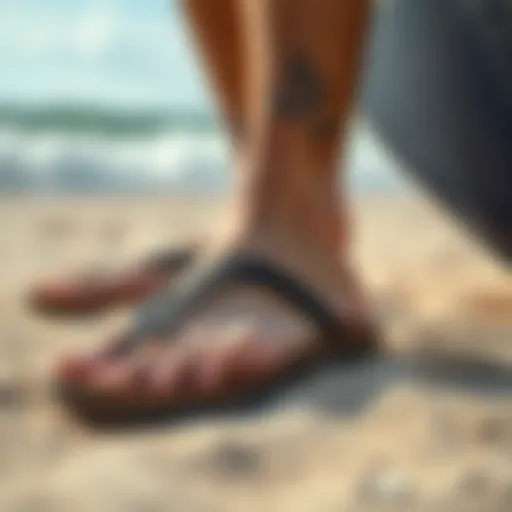Mastering the GoPro Kite Line Mount for Surfing
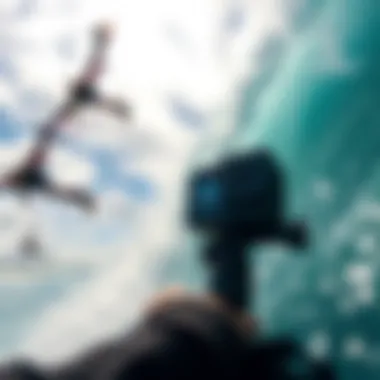
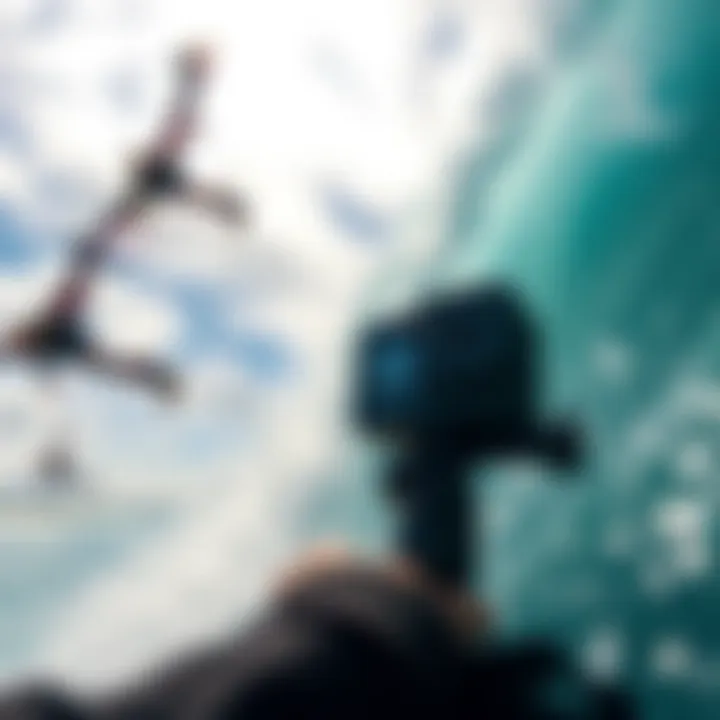
Intro
In the realm of surfboarding, capturing breathtaking moments becomes an art form. For many, the thrill of the sport goes hand-in-hand with the desire to document these experiences. Enter the GoPro kite line mount—an innovative accessory that transforms the way enthusiasts record their adventures. This guide aims to peel back the layers of this equipment, offering insight into its functionality within the unique dynamics of surfboarding.
Navigating through the subsections, we will discuss essential techniques for both beginners and seasoned surfers, delve into the intricacies of surfboard selection, and tackle practical tips for using the GoPro kite line mount effectively. We also aim to explore how this device enhances the overall kiteboarding experience, helping to seize those split-second moments that define a perfect catch or a thrilling wipeout.
Surfing Techniques
Capturing action-packed surfing experiences starts with mastering the techniques of the sport itself. Whether you're just beginning or seeking to refine your skills, understanding various maneuvers can significantly enhance your filming potential.
Beginner Tips for Getting Started
For novices, the initial surfing experience is all about stability and control. Here are some key ideas:
- Find Your Balance: Start on a longboard, which is more forgiving as you learn to balance.
- Practice Paddling: Good paddling techniques are crucial. Ensure your strokes are efficient to catch waves with ease.
- Use Visuals: Watching tutorial videos can help. Use your GoPro to record your practice sessions, allowing you to self-evaluate.
Each session on the water can become a mini-learning experience. Applying the GoPro as a personal coach captures not just the waves you conquer, but also the falls and frustrations that are a part of the process.
Advanced Maneuvers and Tricks
Once you're comfortable, diving into advanced tricks pushes your limits. Here are some maneuvers to consider:
- Cutbacks: Utilize the wave’s energy to gain speed.
- Aerials: Capturing your stunts while airborne creates stunning footage.
- Tube Riding: Getting inside the barrel is the holy grail of surfing, and having it on film elevates its magnificence.
Filming complex moves with the GoPro kite line mount allows for unique perspectives. The mount positions the camera in a way that provides a dynamic view, perfect for displaying both skill and the raw beauty of the ocean.
Surfboard Selection
Having the right surfboard can change the game. Each board serves different styles and surfing conditions, making informed choices essential for everyone from thrill-seekers to relaxed cruise riders.
Choosing the Right Board for Your Style
When selecting a surfboard, consider these factors:
- Material: Foam boards are easier for novices, while epoxy provides durability for more experienced surfers.
- Board Shape: Shortboards for speed, longboards for stability—pick one that aligns with your technique.
- Length and Width: This should correlate with your weight and height for optimal performance.
When equipped with the GoPro kite line mount, selecting the right board ensures footage reflects your surfing style exquisitely.
Surfboard Maintenance and Care
Maintaining your surfboard is crucial to extend its life and performance:
- Rinse after Use: Freshwater rinsing removes salt and prevents mold.
- Check for Dents: Regular inspections for damage can prevent bigger issues in the future.
- Store Properly: Keeping your surfboard out of direct sunlight minimizes fading and resin deterioration.
With proper care, your board will serve you well on the waves, and the footage you capture will be as seamless as your surfing.
Remember, whether you're capturing fun clips for social media or detailed content for post-ride analysis, the quality of both your equipment and your technique will determine the final outcome.
Prologue to GoPro Kite Line Mounts
In the world of surfboarding, capturing those adrenaline-fueled moments becomes as crucial as riding the waves themselves. Enter the GoPro kite line mount. This device isn't just a gadget; it’s a critical tool for documenting the excitement and dynamic fluidity of kite surfing. Emphasizing the significance of the GoPro kite line mount reveals how essential it is for surfers who want their adventures immortalized through high-quality footage. A consideration of why this topic matters is evident when looking at the synergy between technology and sport, ultimately enhancing the overall experience.
Overview of GoPro Technology
GoPro has carved its niche as a cutting-edge camera brand. The technology behind these cameras often combines compact size with impressive capabilities. Picture this: a small, yet robust camera that can withstand the splashes of ocean waves while recording stunning high-definition videos. With features like voice control, waterproofing, and an array of frame rates, GoPro cameras have transformed the way surfers document their rides. There's a richness to the detail captured – from the foam of the crashing waves to the colors of the sunset reflecting on the water. Moreover, GoPro's mobile app allows for seamless sharing and editing, ensuring that every memorable ride reaches your audience.
Purpose of the Kite Line Mount
So, why invest in a kite line mount? It's quite straightforward. The kite line mount attaches securely to your kite lines, offering unique filming perspectives that are simply unattainable through traditional means. This setup allows you to capture the action from a bird's eye view – a thrilling angle that shows the beauty of your maneuvers against the vast expanse of ocean and sky.
"When you film from above, you get to share not just the tricks, but the whole experience, producing footage that tells a richer story of your adventure."
By providing a stable platform for filming, the kite line mount ensures steady footage even during rapid movements. Plus, it frees your hands, allowing you to focus entirely on your surfing while letting the camera handle the documentation. The mount epitomizes the marriage of technology to experiential sport; it helps translate the thrill of being in the surf into something others can appreciate and enjoy. This aspect alone supports its purpose in the modern surfing experience, making it an indispensable item in many surfers' kits.
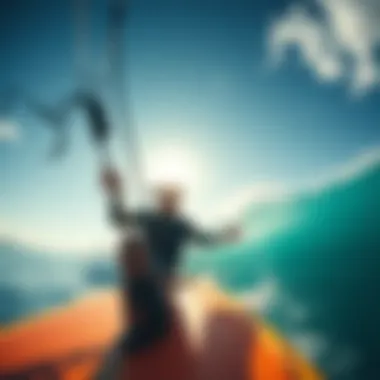
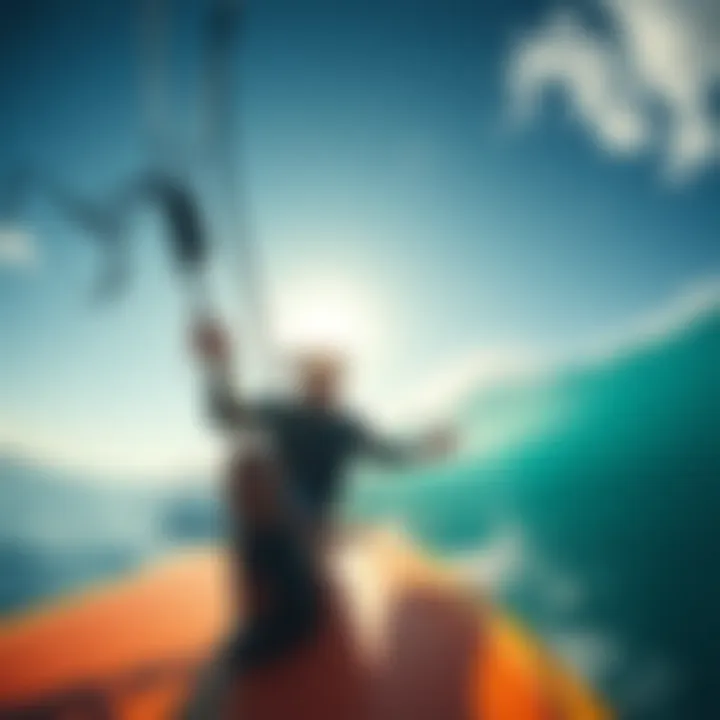
Components of a Kite Line Mount
Understanding the components of a kite line mount is crucial for anyone looking to enhance their surf filming experience. Each part plays a pivotal role in ensuring that your GoPro functions optimally, captures stunning footage, and withstands the rigors of surfboarding. These mounts are designed to provide flexibility and security while you ride the waves. Here, we will delve into the specifics of the mounting hardware and how compatibility with different GoPro models can affect your performance and filming output.
Mounting Hardware Explained
The heart of any kite line mount lies in its hardware, the very backbone that keeps your camera secured during intense rides. At first glance, the components might seem straightforward—hooks, clips, and straps. However, each piece is engineered with precision to meet the demands of extreme conditions.
- Material Quality: Most mounting hardware is made from durable materials, such as high-grade plastics or stainless steel, which can withstand salty water and strong winds. This choice of material ensures longevity and reliability.
- Adjustment Features: Many mounts come with adjustable components, allowing surfers to tailor the angle and position of their camera. This can make all the difference in capturing that perfect wave or aerial trick.
- Safety mechanisms: Some setups are equipped with redundant attachments, such as safety lanyards, that minimize the risk of losing your camera should a mount fail. Security isn’t just a luxury; it’s a necessity when you’re in the ocean.
Having a solid understanding of these components helps not only in installation but also in maintaining the integrity of your setup.
Compatibility with GoPro Models
When it comes to using a kite line mount, compatibility with your GoPro camera model can’t be overlooked. Different GoPro generations—be it Hero9, Hero10, or the latest Hero11—come with varying features that affect mounting compatibility.
- Mounting Base Compatibility: Some mounts are designed to fit multiple GoPro models seamlessly. Check the specifications to ensure the base is compatible with your camera’s design.
- Weight Considerations: As newer GoPro models have become lighter and more compact, choose a mount that complements the design. An overly heavy or bulky mount may throw off your balance while kiteboarding, impacting your performance.
- Accessory Integration: With many GoPro models supporting various accessories like filters or external microphones, it’s vital to verify that a kite line mount allows for these extras without blocking essential camera functions.
Understanding how these two components—mounting hardware and camera compatibility—interconnect gives surfers and videographers better results and enhances their overall experience. It allows you to capture stunning visuals while ensuring that your camera setup is reliable throughout your surfing adventures.
"When you find the right mount for your GoPro, you’re not just investing in a piece of equipment; you’re investing in your story, documenting every breathtaking moment as you dance with the waves."
In summary, the components of a kite line mount are intricately designed to optimize your filming experience while ensuring the safety and security of your GoPro camera. Whether it’s about the quality of materials or how well your specific model integrates with the mount, knowing these elements helps create a more fulfilling surf adventure.
Installation Techniques
The proper installation of a GoPro kite line mount is not just an afterthought; it serves as the backbone for a successful shooting experience while surfing. When the mount is affixed successfully, it dramatically enhances the quality of the video footage, capturing dynamic movements with clarity. Besides that, a well-installed mount contributes to safety by ensuring that your gear is secure and won’t become a hazard during your water adventures. The following sections break down the essential preparations, provide a clear step-by-step guide, and highlight common errors that users might run into, helping you become more adept and confident with your mounting techniques.
Preparing for Installation
Before diving headfirst into the actual installation process, it’s crucial to take a moment and gather all necessary materials and understand the environment. Here are a few preparations worth considering:
- Assess your Equipment: Ensure your GoPro model is compatible with the kite line mount you've selected. Not all versions fit every model, so check specs and references from the manufacturer.
- Gather Tools: Have all tools handy, like the provided screws, a screwdriver, and possibly a wrench. It’s better to gather everything up front than scramble during installation.
- Choose the Right Conditions: Whether you’re at the beach or on a boat, don’t start mounting gear in strong winds or rough waters. Calm conditions allow for a better focus and less chance of mistakes.
Additionally, take into account the location where you’ll be shooting. Different setups may require various angles or positions for optimal footage. Taking these factors into account will set the stage for a seamless installation.
Step-by-Step Installation Guide
Now that you're geared up and ready to go, let's walk through the installation process. Follow these steps carefully to set up your GoPro kite line mount:
- Choose Attachment Point: Select a section on the kite line that does not obstruct your surfing. Generally, it’s placed closer to the bar rather than the kite.
- Open Mounting Hardware: Loosen the screws of the kite line mount. Make sure to lay everything out neatly, so you don’t lose pieces.
- Attach the Mount: Slide the mounting hardware over the chosen part of the kite line and secure it. Ensure that it’s snug. Remember, it shouldn’t be too tight either; flexibility is key with the kite line.
- Secure the Camera: Once the mount is stable, attach the GoPro securely. Make sure it’s facing in the desired direction, often aimed just slightly forward to capture the action ahead.
- Test for Stability: Once everything is in place, give it a gentle tug to check if it’s secure. If it wiggles, go back and tighten it up.
In the end, checking each step thoroughly helps prevent any unintended hiccups down the line.
Common Mistakes to Avoid
Even seasoned surfers can overlook important details during installation. Here are some common missteps to sidestep during your next installation:
- Ignoring Compatibility: Not verifying if the mount fits your GoPro model might lead to frustrations when you get to the beach.
- Mounting at Wrong Angle: Attaching the GoPro at an incorrect angle can cause the footage to be useless. Spend a moment assessing where the action will happen.
- Neglecting Tightening: Failing to tighten the screws adequately might result in camera loss, not to mention the potential for panic to ensue while on the waves.
"A good mount is like a loyal friend: it keeps your back covered in tough times."
- Not Testing Before Use: Many people forget to test the mount beforehand. Do it in controlled conditions to ensure everything is stable, away from the chaos of a busy surf day.
By being mindful of these common pitfalls and following the steps methodically, you’ll be well on your way to a successful filming session that captures your greatest surf moments without a hitch. Taking the time to learn these installation techniques pays off in the end, both for quality footage and for peace of mind.
Benefits of Using a Kite Line Mount
Using a kite line mount for your GoPro is like finding a golden ticket in your surfing experience. It multiplies the potential for creating exceptional content, capturing not just the action, but the spirit of the sport. When you're riding the waves, speed and movement are your best friends. Here we will explore the different benefits of employing this clever piece of gear that can amplify your surf footage.
Enhanced Filming Angles
The position of the camera can make or break a shot. The kite line mount cleverly places your GoPro high above the surf, allowing for dynamic angles that can showcase the roar of the ocean and your skills in a way that ground-level shots simply can't. Think about it. When you're capturing images at eye level, you're missing out on the sweeping panoramas that can tell a story far beyond just the wave.
- Bird’s Eye View: Offering a bird’s eye view, the mount lets you capture the grandeur of rolling waves and the expanse of the horizon.
- Dynamic Range: You can achieve footage that appears to dance across the waves. This contrasts vividly with traditional camera placements that can feel static.
- Unique Perspectives: When positioned at different angles, you can create unique perspectives that surprise and delight your audience. It’s like putting them right in your shoes as you shred through the ocean.
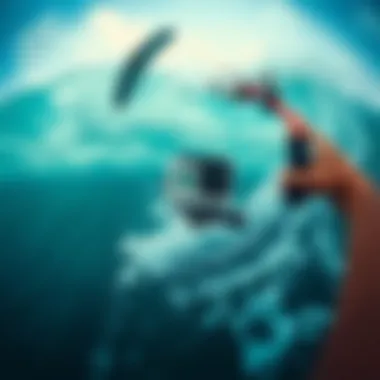
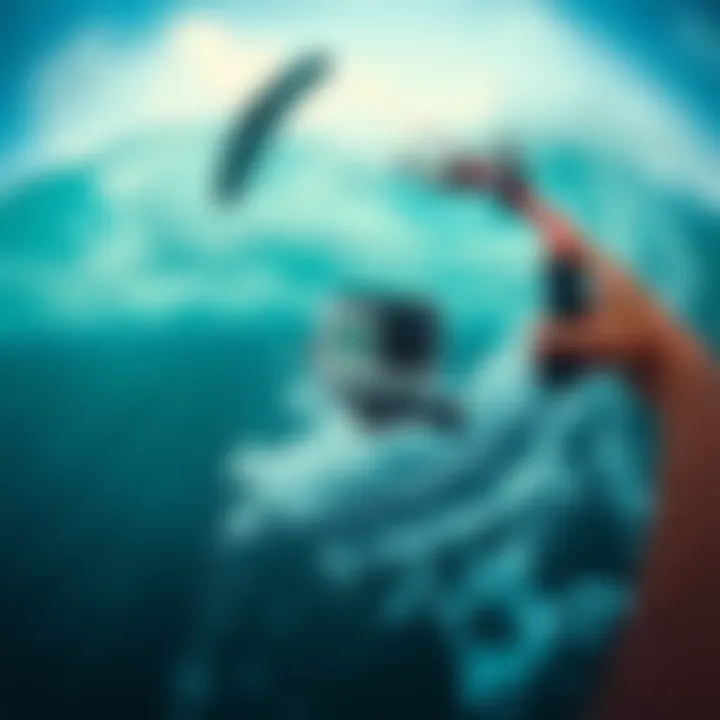
Stability in Rapid Movements
Surfing is anything but calm. The surfboard zips over a tangle of waves while you’re maneuvering to fit your tricks in a split second. The kite line mount provides stable footage even during these chaotically dynamic moments.
- Vibration Reduction: This mount design minimizes vibrations, meaning your footage retains clarity and definition.
- Fluid Motion: The camera's position doesn’t get jostled around as you might when holding a handheld device. Instead, your movements and the ocean’s chaos translate into smooth, flowing graphics.
- Rider Confidence: Knowing your camera is secure frees you to focus entirely on your ride. Less worry about equipment means more flow in your experience.
Creating Immersive Content
In the world of videography, immersive content reigns supreme. With a kite line mount, your potential for creating an engaging narrative blossoms. It’s not just about documenting; it’s about telling a story.
- Relatability: By capturing the ride from a top-down perspective, viewers feel an immediate connection to the experience, making them wish they were right there with you.
- Engagement Factor: The captivating angles and stable footage can hook viewers, resulting in shares and likes. Understand that the viral effect hinges on how well you can bring the viewer along on your journey.
- Emotional Resonance: Immersive content can draw out emotional responses. By showcasing your triumphs and battles against the water, you create a tapestry of experience that resonates with fellow surfers and enthusiasts alike.
"The kite line mount transcends the ordinary, capturing not just images, but the essence of the ocean's embrace and the thrill of conquering the waves."
Optimal Usage Scenarios
When it comes to utilizing a GoPro kite line mount, understanding the best usage scenarios can make a world of difference in capturing breathtaking footage. The right situation not only enhances the quality of your videos but also showcases the thrill of surfing with a unique perspective. Painstaking attention to various scenarios will ensure that surfers, travelers, and outdoor enthusiasts get the most from their kite line mounts.
Capturing Wave Action
To truly encapsulate the essence of surfing, capturing wave action is paramount. With a kite line mount, you can position your camera directly above the rider, allowing for an immersive viewpoint that is simply unattainable with standard mounts. This vantage point showcases not just the surfer but also the majestic waves around them, creating a dramatic visual experience.
Benefits of This Position:
- Dynamic Angles: Placing the camera high above, recordings reflect the exhilarating rise and fall of both the surfer and the waves. This versatility captures the action in an engaging manner.
- Uninterrupted Views: A kite line mount generally minimizes obstructions compared to traditional filming methods. The clear view of the rider's motions can amplify the excitement and intensity of the footage significantly.
- Consistency in Experience: This positioning maintains the action in focus, making it easier to get consistent high-quality footage even under rapid changes, such as waves crashing or shifts in wind direction.
By mastering the art of wave action photography, surfers can transform their ordinary clips into spectacular showcases of their adventures on water.
Documenting Tricks and Techniques
Every surfer has a repertoire of signature tricks, and documenting them serves multiple purposes, from personal growth to sharing with the broader surfing community. The kite line mount allows for enhanced coverage of aerial maneuvers and other complex techniques.
Things to Consider:
- Close-Up Details: A kite line mount can be adjusted to capture specific techniques up close, providing clarity on foot placement and body posture during intricate tricks. This aids in self-improvement and helps coaches offer tailored advice during training.
- Perspective of Fluid Motion: The mount's flexibility permits cameras to follow the movement without losing sight of the fluid motion, making every twist and turn visually interesting.
- Showcase Progression: Recording tricks over time can reveal improvement, a fantastic way to track growth. Consistently reviewing footage provides insights on what to refine in their technique.
Through thoughtful documentation of tricks, surfers cultivate a deeper connection with their sport and inspire others to push their limits as well.
Recording Group Sessions
Surfing is often a group activity where camaraderie reigns supreme. Recording group sessions through a kite line mount can immortalize those shared experiences, highlighting the social aspect of the sport.
Key Advantages:
- Collective Energy: Capturing the buzz of multiple surfers together not only displays skill but also the fun and friendships formed on the waves. Footage that includes friends riding alongside each other encapsulates the collective vibe.
- Memorable Moments: Often, the best stories stem from collaborative adventures. The kite line mount can seize those spontaneous moments, whether it's a successful trick or a light-hearted conversation amid the surfing action.
- Shared Growth: Watching group footage collectively can be an invaluable learning resource. Surfers can critique each other’s performances in a constructive manner, enhancing overall skills for everyone involved.
Recording group sessions fosters a sense of community and serves as a fantastic reminder of shared experiences, solidifying bonds that often last a lifetime.
"In every wave and shared moment, surfing becomes more than just a sport; it transforms into a collection of stories, experiences, and friendships that define a life on the water."
In summary, knowing the optimal usage scenarios for a kite line mount dramatically enhances a surfer's ability to capture the powerful dynamics of their sport. Whether it’s nailing that perfect wave, showcasing precision in tricks, or cherishing group outings, the mount serves as a powerful tool for documentation, serving both the surf community and individual surfers alike.
Maintenance and Care
Maintaining your GoPro kite line mount is crucial to ensure longevity and performance, especially for surf enthusiasts who depend on this equipment to capture their adrenaline-fueled adventures. Proper care not only enhances the mount's durability but also ensures that the camera operates smoothly and produces high-quality footage. Regular maintenance can prevent common issues that arise from sand, saltwater, and general wear and tear.
Cleaning the Mount and Camera
Cleaning your GoPro kite line mount and camera is essential after each use, particularly if you've been in saltwater or sandy environments. Here’s how to do it:
- Rinse with Fresh Water: Begin by rinsing the mount and camera with fresh water. This is crucial as it removes salt and sand that can cause corrosion and scratches.
- Use a Soft Cloth: After rinsing, take a soft cloth—microfiber works wonders—and gently wipe down the surfaces of the mount and the camera. Avoid abrasive materials, as they can scratch the lens and delicate parts.
- Check for Debris: Pay close attention to the mount's crevices and joints. Debris can accumulate, affecting the mount's stability. A soft brush can assist in getting into those hard-to-reach places without damaging any components.
Tip: Establish a quick routine for cleaning your gear right after you’re done kiting. The sooner you do it, the easier it will be, preventing salt crystallization and dirt buildup.
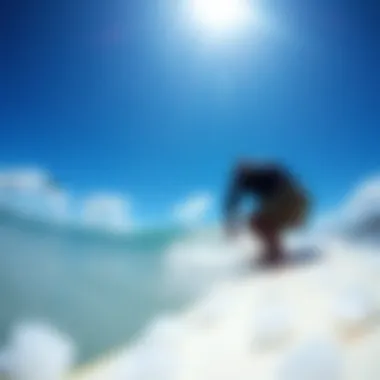
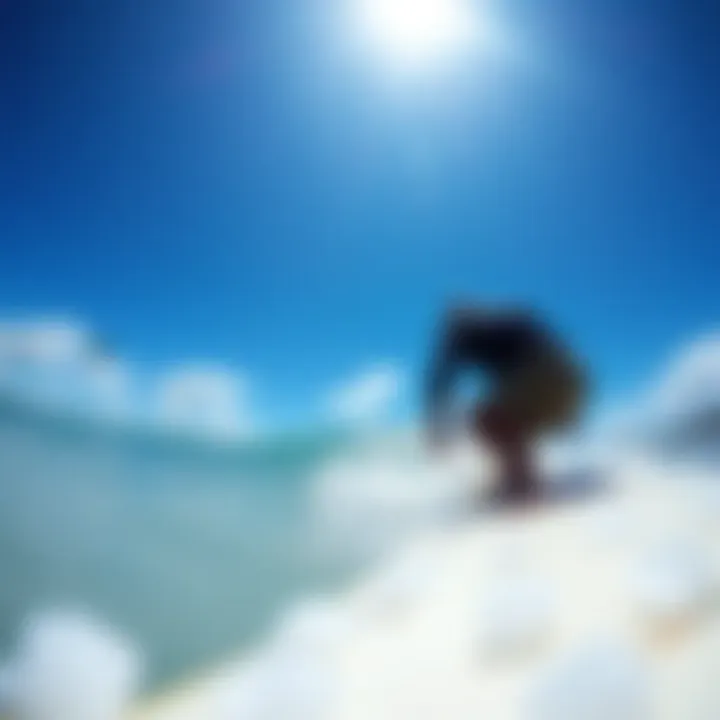
Inspecting for Damage
Regularly inspecting your equipment is a best practice that should not be overlooked. Here's a checklist to help you:
- Look for Cracks or Breaks: Examine the mount for any visible damage. Cracks, nicks, or breaks can compromise the integrity needed to securely hold your camera during water sports.
- Evaluate the Attachment Points: Check where the mount attaches to the kite line. Ensure that everything is tight and in good shape, as weak points here could result in losing your camera mid-ride.
- Examine the Camera's Housing: If your camera's housing is scratched or compromised, it may affect its waterproofing capabilities. Be vigilant about any signs of wear.
Proper Storage Techniques
When your GoPro kite line mount and camera are not in use, proper storage can help extend their lifespan. Here’s how to store them effectively:
- Keep in a Dry Place: Always store your equipment in a cool, dry location. Humidity can lead to mold and corrosion. Use a case that offers protection against moisture and dust.
- Use a Protective Case: Invest in a high-quality protective case for your GoPro and equipment. Make sure it has padding to prevent knocks and scrapes during transport.
- Avoid Sun Exposure: Prolonged exposure to sunlight can degrade the material of the mount and camera. Store them away from direct sunlight, especially on hot days.
By implementing these maintenance and care techniques, you can ensure that your GoPro kite line mount remains in tip-top shape, allowing you to focus on what truly matters—capturing those epic surfing moments.
Safety Considerations
When engaging in kite surfing, safety isn’t just a side note—it’s the backbone of the experience. Using a GoPro kite line mount effectively can undeniably enhance your filming, but it comes with responsibilities. It's crucial to think about how the camera setup can impact your safety and that of others around you. This section digs into key aspects of securing your mount, maintaining focus while on the water, and keeping an eye on the weather, all aimed at ensuring you enjoy the ride while reducing risks.
Ensuring Secure Mounting
One of the first steps in guarantee safety is focusing on how to properly mount your GoPro. A securely fastened camera means less chance of it breaking loose and causing harm to you or fellow surfers. Review your mounting points meticulously; make sure they are clean, dry, and free from any debris that could affect adhesion.
In addition, regularly inspect the gear. A little periodic check-up can go a long way. Look for signs of wear or degredation on the mounting hardware. If you happen to notice any signs of loosening, it's best to address it before hitting the waves. Misalignment can lead to disastrous results not just for the camera, but for safety on the whole.
Notably, a camera that falls off mid-ride can create a hazardous situation for those around. Here’s a quick checklist to help you:
- Confirm the integrity of mount posts and screws.
- Ensure straps are tightly secured prior to launching.
- Avoid overloading the mount with extra attachments that may cause instability.
"A well-secured mount not only enhances the filming experience but dramatically aids in risk management on the water."
Avoiding Distractions While Surfing
A critical aspect of a successful kite surfing session is the ability to focus. When you’re out there riding the waves, any distraction can lead to serious mishaps.
Having a GoPro mount can shift your attention if not managed properly. To prevent this, familiarize yourself with your camera settings and placements before you enter the water. You wouldn’t want to fiddle with controls while in the heat of the action, that’s just asking for trouble.
Additionally, remember, the first priority is always riding. Consider how the added weight or presence of the camera affects your balance and control. It’s all about finding that sweet spot where your filming setup feels like an extension of yourself rather than a hindrance.
Weather Considerations When Filming
Mother Nature can be unpredictable and can easily turn a beautiful day into a scary one. Weather plays a vital role when you're on the water with a GoPro.
Before setting off for a session, check the forecast—wind speeds, storm alerts, and tides can make or break your day and affect your safety. Strong winds can create rough waters, and mounting a camera under extreme conditions may not be the best idea. Like any seasoned surfer will tell you, it's often smarter to wait for better conditions.
In addition, be cautious of where your filming position is set relative to wind direction. You want to ensure that any falling debris or water impacts don’t catch you off guard. Here are some weather-related tips for safe filming:
- Check wind speeds; avoid filming in extreme conditions.
- Be prepared for sudden weather changes; pack for versatility.
- Stay alert to your devices; water can easily compromise electronic equipment.
By keeping safety considerations in mind, not only are you protecting yourself, but also paving the way for a more enjoyable and fulfilling kite surfing experience.
Epilogue: The Impact of GoPro on Surf Culture
The introduction of GoPro cameras into the world of surfing has marked a significant shift in how surfers document and share their experiences. For enthusiasts, the implications stretch beyond simple footage; they delve into a transformation in the very fabric of surf culture itself. As the waves crash and boards glide, there's an entire world out there that deserves to be documented, and GoPro makes that feasible.
How Filming Transforms the Surf Experience
Surfers often seek a deeper connection with the ocean, and filming with GoPro allows them to capture that essence uniquely. The thrill of riding a wave is amplified when it can be relived through footage, enabling surfers to critique their technique or share experiences with friends and family.
The essence of surfing is often about the moments beneath the sun, alongside camaraderie with fellow surfers. With the ability to capture trick attempts, wipeouts, and awe-inspiring rides, GoPro changes how people engage with the sport. Social media platforms now brim with clips transformed into stories that celebrate individual journeys, skills, and the beauty of nature.
"With GoPro, every drop-in becomes a potential highlight reel, showcasing not just talent but the vitality of the surf community."
For many, it breeds a culture of sharing and collaboration with other surfers. It encourages not just personal growth but inspires others to hit the waves and seize their own experiences. This communal aspect significantly enhances how the surf culture evolves, providing a shared space for inspiration and motivation.
Future Trends in Surf Filming Technology
As technology continues to progress, the evolution of surf filming is right on the crest of the wave. The future promises smaller, more sophisticated cameras that are capable of producing high-definition footage in even the most challenging conditions. This could include advancements like drones providing aerial views or 360-degree cameras that give a complete perspective of the experience.
Moreover, augmented reality (AR) and virtual reality (VR) are poised to find their way into surf culture. Imagine putting on VR goggles and re-experiencing that perfect wave ride in your living room. These innovations might not only help in training but may also turn our view of surf content on its head. Content could transform into immersive experiences, inviting audiences to live the thrill of the surf from the comfort of their own homes.
In the coming years, the synergy between surf culture and technology will likely deepen. GoPro cameras and similar devices are set to become indispensable tools not just for personal documentation but also for storytelling that might inspire generations to come. Surfing is not just a sport; it's a rich culture, and as technology continues to blend with tradition, the stories surfers tell will resonate even further, marking a new chapter in surfing’s history.

